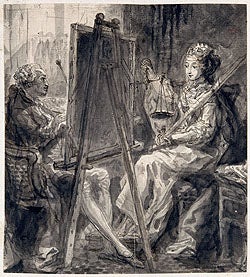Gabriel de Saint-Aubin (1724–1780)
October 30, 2007, through January 27, 2008
| |
 |
|
|
| |
Saint-Aubin, Gabriel de Saint-Aubin Painting an Allegory of Justice, 1768, pen and black and brown inks, black, gray, and brown washes, black chalk, Musée du Louvre, Département des Arts Graphiques, Paris |
|
|
Reportedly called a “priapic draftsman” by the painter Greuze, and said to have produced “one hundred thousand drawings” by his gently disapproving brother, Charles-Germain, Gabriel de Saint-Aubin was above all a draftsman of genius; a brilliant, idiosyncratic engraver; an engaging, if not always successful, painter; and a mediocre poet, it must be admitted. He was also the unsurpassed chronicler of the City of Paris in the heyday of the Enlightenment, capturing all aspects of its cultural life with wit, imagination, affection, and pride.
Born to a family of skilled craftsmen — his father was an embroidery designer, as was his elder brother, the family biographer, Charles-Germain de Saint-Aubin (1721–1786) — Gabriel surpassed all of his family in artistic talent but failed to meet their expectations that he would become a history painter at the Académie royale. He did study at the Academy — where his masters included François Boucher (1705–1770) and Étienne Jeaurat (1699–1789) — and he competed there on several occasions during the early 1750s for the Grand Prize that would have provided him with a scholarship to study at the French Academy in Rome. He failed three times and is often said to have thrown aside all hopes of a traditional artistic career and hastened out into the thoroughfares of Paris to sketch everything in sight. In fact, Saint-Aubin worked primarily as an illustrator before, during, and after the brief period in which he competed at the Académie royale.
By 1747 the artist had begun his career as a teacher of figure drawing in the École des Arts founded by the architect Jacques-François Blondel (1705–1774). He was also active in supplying figures for elaborate architectural drawings that recorded municipal fêtes celebrating great events at court. His teaching and early illustrative commissions were the catalyst for his lifelong interest in specifically Parisian themes, usually related to architecture and including allegorical interpretations of contemporary life. The blending of fact and fancy that characterized Saint-Aubin’s earliest
works would forever remain a hallmark of his art. It was through a network of contributing forces that Paris became the dominant theme of Saint-Aubin’s formal and informal production. He drew on every aspect of his artistic background to express his fascination with events in Paris that were attracting local, national, and — sometimes — international attention. In his capacity as a commemorative illustrator, the artist had occasion to portray most major occasions in the lives of the French royal family between 1750 and 1780. As an associate of architects and engineers, he glorified great building projects of national significance and visualized utopian schemes. Developing an almost reportorial sense of current events, Saint-Aubin took it upon himself to capture for posterity such memorable moments as calamitous fires, the appearance in Paris of foreign dignitaries, public courses on scientific subjects designed for the instruction and amusement of sophisticated laymen, theatrical performances, and lavish entertainments at fashionable pleasure palaces. Cumulatively, his work became an embodiment of contemporary Parisian history.
The artist never married and died in penury several months before his fifty-sixth birthday.
The accompanying catalogue is available, in both English and French, in the Museum Shop.
Major funding for Gabriel de Saint-Aubin (1724–1780) has been provided by The Florence Gould Foundation. Additional generous support has been provided by The Christian Humann Foundation, the Michel David-Weill Foundation, and The Grand Marnier Foundation.
 |
|
The project is also supported, in part, by an award from the National Endowment for the Arts. |
|


